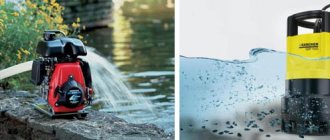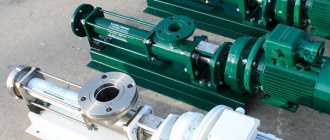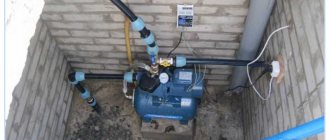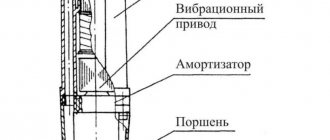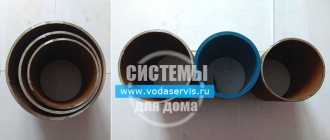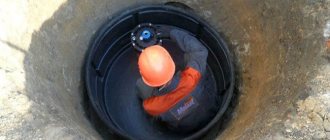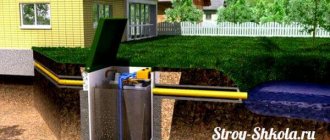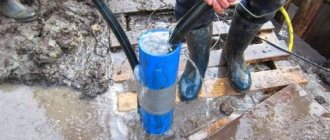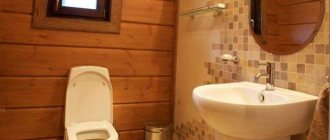Blanket 220x200 cm
1799 ₽ More details
Blanket 220x200 cm
999 ₽ More details
Office sofas
Many owners of private properties with basements and cellars are faced with the problem of excess moisture in rooms below ground level. This occurs due to the influx of groundwater, as well as seasonal flooding and in the event of an accident. Water in the basement negatively affects the foundation, eroding its ceilings, mold and dampness appear in the building. Stationary and portable electric pumps are used to remove excess water. How can you remove water from the basement? Let's consider this issue in more detail.
Pump selection
When choosing pumps for the basement, you can choose both surface and submersible models. This does not have any significance in technological terms, but from a technical point of view this approach may turn out to be correct. For example, when a one-time pumping is needed, the surface option will be cheaper, but for a regular process it is better to choose submersible models.
Surface pumps
A surface-type water pump is used for one-time pumping of a tank Source tehnika.expert
In most cases, surface pumps for a basement or any tank are used in a one-time mode for one-time pumping. Such a device is air-cooled and this is quite enough for several hours of engine operation. Moreover, the entire electrical circuit of the unit has only surface protection in the form of covers and casings, therefore, direct contact with water is contraindicated - this will lead to a short circuit, and worse, to electric shock to operating personnel. The productivity of such devices, as a rule, is not very high and reaches no more than 1500 l/hour - this is enough for a one-time pumping, but not for a stationary device.
The positive qualities of surface devices include the following factors:
- simplicity of design and reasonable cost;
- no work is required for operation - the pump is simply installed on the ground;
- in operating mode it is possible to monitor the unit, which significantly reduces the risk of breakdowns;
- After pumping is completed, the equipment can be easily assembled and transported (transferred) to another location.
Of course, you can never do without negative characteristics, and this applies to absolutely all units, because if you want, you can discover a lot, but in this case, these are:
- limitation on the height of liquid lifting up to 9 m;
- it is impossible to pump out water without a residue - when completed, air begins to enter the hose and the engine turns off automatically (something similar to a dry-running sensor);
- the unit creates a lot of noise when operating;
- In bad weather, the engine has to be covered with something to prevent water from getting inside.
At the end of the work, as you already understood, the pump will turn off automatically as it will begin to draw in air, so the constant presence of a person during operation is not necessary. Regardless of your assessment, such pumps are most often chosen for watering gardens, pumping water, and cesspools. That is, preference is given to surface models in cases where such pumps are not used regularly.
Note: moisture accumulates in the pump compartment of the surface pump all the time, so its operation or storage at subzero temperatures is not recommended.
Briefly about the main thing
Drainage pumps, originally created for draining basements, have now significantly expanded their scope of application. They can be found in wells and swimming pools, cleaning pits, basements, and pumping wells.
Submersible models have an advantage over their surface counterparts when lifting water from a well, but they are more difficult to maintain. In a suburban area, drainage specialists are responsible for a lot of work, which is why a competent approach to their selection is so important.
When comparing different versions of devices, pay attention to their main characteristics: power, height of water rise, ability to pump impurities. A suitable model is determined based on the type of work planned; for large volumes of work, pumps with a stainless steel housing and motor shaft are preferred.
Ratings 0
Video description
Spring flood in the basement.
Drainage pumps
Such a unit is ideally suited for pumping water out of the basement Source met-all.org
As you understand, during operation the submersible drainage pump is always under water, therefore, there can be no talk of any penetration of moisture inside. Both the electric motor and the pump part of the device are enclosed in a sealed housing made of stainless steel or cast iron, which reliably protects the power unit and all rotating elements (shafts, bearings, gears). In most cases, disassembly of these models cannot be done, since the case is hermetically sealed, but it also cannot be said that there is a need for such disassembly - the devices usually last much longer than indicated in the warranty card.
Considering the fact that the pump has to pump out dirty water that passes through the mesh filter of the device. In the vast majority of models, the cell of such protection is capable of passing through solid particles no larger than 5 mm in size along any of the cross-sectional parameters. This means that when pumping out, the pump of the unit will lift up all the small debris that is in any case present in the basement, no matter how cleanliness is monitored there. Of course, larger fragments in the form of leaves or branches will linger on the mesh, which can lead to the engine stopping - the automation will work when the water supply stops. But this is not a problem - in most cases, when the impeller stops, the debris simply comes off the mesh and falls to the bottom, so you just need to lift the pump a few centimeters from the bottom.
The drainage pump with a float switch is protected from dry running Source met-all.org
Sump pumps may or may not be equipped with a float to shut off the motor. Such a device protects the electrical device from dry running, therefore extending its service life. If the armature rotates without cooling, the engine will overheat, which leads to failure of this unit.
Important information! In the event that sludge rises from the bottom of the pumped out tank, the drainage pump may jam and it will burn out from overheating. Therefore, it is not recommended to operate it close to the ground bottom.
Fecal pumps
Only a shredder on fecal equipment can cope with solid contents. Source strojdvor.ru
For heavily contaminated liquids, submersible fecal pumps with a shredder that process large fragments of garbage, such as branches, leaves, stuck together lumps of soil, etc. are the best choice. In addition, the pump pump is designed to handle debris from sand and viscous liquids (sludge and feces). It is noteworthy that the pruner, which cuts large pieces of debris, is located at the entrance to the working chamber, therefore, only small particles get there, allowing liquid to be pumped from place to place.
To buy the “right” fecal pump, you need to pay attention to its markings:
- The presence of only numbers, without any letter abbreviation, indicates that this is a submersible drainage pump capable of pumping liquid with large fractions up to 5 mm.
- The presence of the letter “f” indicates that this is a fecal pump capable of processing rags and branches with a diameter of up to 35 mm in the shredder, which is almost two man’s fingers thick.
- The presence of the letter “n” indicates the ability of the unit to work with aggressive liquids for a long time.
Note: Any of the above pumps can be used to pump water out of the basement.
The unit is located on the surface of the liquid using a special float Source nasosovnet.ru
How to prevent water penetration
To get rid of water in the basement, homeowners can be advised to use several modern methods aimed at combating liquid penetration. The first of them involves the creation of a ring drainage, which is placed at the level of the base of the foundation around the walls and helps to ensure that liquid is retained by the drainage system. The second is the use of waterproofing applied to the floor and walls. The waterproofing layer will become a serious obstacle to water penetration.
This is interesting: how to get rid of water in the cellar without a pump.
Equipment for pumping cesspools
This group of units includes equipment for specific purposes. The fact is that they must be able to pump out not only liquids, but also solid waste. Since the body of such equipment is not completely in the water, it is called a semi-submersible pump. The intake part is located in the working environment, and the protected electric motor is mounted on the float.
The performance of this type of equipment is low, but at the same time it consumes very little power. Considering the scope of the task (the cesspool of a small country house or mansion), this solution is fully justified.
Attention. For all its positive qualities, the semi-submersible pump is not without its drawbacks: not the highest efficiency, lack of a grinder for solids in the design. When choosing equipment, you need to take these features into account.
Popular/best models
Below is a list of the best drainage sump pumps:
- Pedrollo VXm 10/35. Italian manufacturer. Capable of working in very dirty water conditions. Price about 13 thousand rubles.
- Karcher SDP 14000. Made in Germany. Effective when working with slightly contaminated water. It comes with a built-in filter that protects the unit from negative influences. It belongs to the deep category, as it is capable of lifting dirty liquid from a depth of about 8 m. Estimated cost is 8 thousand rubles.
- Grundfos KP 350-A-1. Produced by a company from Denmark. Used when pumping liquid from washing machine drains, etc. For environments with minimal impurities. Productivity is up to 14 cubic meters per hour. The body is made of stainless steel. Estimated cost 27 thousand rubles.
- Gilex. Water pump made in Russia. It is used for pumping out liquids of various types. The kit includes a 10 m power cord, which allows you to move it to a convenient place. This manual surface pump is convenient for household use. Capable of creating pressure up to 11 meters. Estimated cost 5 thousand rubles.
- Al-ko Drain. German origin. This is a small submersible pump with a capacity of up to 190 liters per minute. Estimated price 3.5 thousand rubles.
Installing a waterproof barrier in the basement
There is a solution to the problem of basement flooding in houses on flat areas, which, although it does not eliminate the cause itself, like drainage, allows you to completely do without any temporary devices. We are talking about organizing a waterproof barrier inside the basement - essentially a “trough” over the entire surface of the walls and floor. How this is done will be discussed further.
Generally speaking, there is no need to make such a barrier along the entire height of the basement walls. It is enough to raise its level 100 mm above the highest groundwater level. Of course, you can simply make a barrier to the soil level - water simply cannot rise higher, but the high price of the materials used in this method requires corresponding savings, and this can only be achieved by avoiding overspending. Accordingly, the first thing that needs to be done is to determine the level of the primer and, thereby, determine the upper limit of waterproofing.
Next, you need to decide what exactly needs to be done to create a waterproof barrier. There are two options here:
- If the basement is a reinforced concrete monolith-trough, poured in one go, then it will be enough to treat it from the inside with impregnating waterproofing. This is a special mixture that penetrates into the pores and microcracks of concrete and contains additives that crystallize in water. The crystals formed clog all the pores in the concrete, thereby forming a waterproof barrier - what we need.
- Any other case, including a reinforced concrete monolith poured several times, because even this option cannot be considered a full-fledged monolith, since each new pour over the existing concrete creates a highly permeable boundary between different layers; for water it is, in fact, almost a crack. Penetrating waterproofing, which clogs only microcracks and pores, will be powerless here. What can we say about all sorts of combined options, for example, walls made of concrete blocks or bricks, the floor is a monolith. In this case, it is necessary to make an additional inner layer of waterproofing materials. Coating or adhesive waterproofing is not suitable here, since it has an increased risk of peeling, especially under water pressure. It is necessary to use materials that have high adhesion to concrete and brick surfaces and create a high-strength layer that does not crack over time. This is exactly the option we will consider.
First, let's decide on the necessary materials and tools. We will need:
- Sand concrete mixture.
- Impregnation waterproofing.
- Reinforcing waterproofing.
- Mixer and kneading container.
- Brushes, rollers, brushes.
- Spatulas.
Let's get to work.
We have a basement with walls made of concrete blocks, the floor is a monolith, which was poured after the walls were built. When spring comes, the basement floods. By the way, this also happens in case of prolonged rains.
It is quite obvious that the main problem areas are the junction of the walls with the floor and the tile joints.
1. Pump out water from the basement. This can be done manually or using any suitable pump, such as a baby pump. Please note that they come in two types: with lower or upper water intake. It is clear that it is better to use with the lower one. By fixing it vertically, you can pump out almost all the water. In our case, there was no such pump, so pumping had to be done in two stages: pumping to the minimum possible level - approximately 30 mm, and manual residual pumping.
As the pump drains, it will emerge from under the water. Very important! It only cools down when it is in water, so you need to constantly water it to keep it from overheating. Next, we place the pump in a large bucket, where we scoop out the water with a suitable tool.
We sweep the remaining water into one puddle with a brush and pump it out in the same way. As a result, we get an almost dry room. The water, of course, will rise. If the work is done slowly and does not interfere, then you can move on to the next stage. Otherwise, the work will have to be postponed until a more suitable time.
2. We process the junctions of walls and floors, as well as seams. We mix the sand-concrete mixture and use a spatula to form skirting boards with a height and width of about 40–50 mm along the entire perimeter of the room. We putty the seams between the slabs with the same mixture. Leave to dry. The next day, when the baseboards are in place, we move on to the next stage - treatment with impregnating waterproofing. High humidity in the room will not hurt - the impregnation works in water, the main thing is that there are no puddles. We pump them out using the method described above.
3. Mix the waterproofing mixture with a mixer according to the attached instructions.
4. Use a brush to cover the entire surface to be treated with the resulting creamy mass.
Leave to dry. After the time specified according to the instructions, apply the second layer. After treatment, water will not flow through the surface of the concrete - these are the planes of the blocks and the entire floor. The seams and junctions remain. We will process them when the second layer of penetrating waterproofing dries.
5. If necessary, pump out the water again.
6. Mix the armoring solution according to the instructions.
7. Similar to penetrating waterproofing, apply the resulting solution with a brush to the entire surface to be treated. We pay special attention to the seams between the slabs and the junctions.
8. The first layer is the base layer. It is necessary to wait the required time for setting and apply the second layer. Before this stage, all flaws will be clearly visible, in the form of oozing microholes. The water leaves clearly visible marks; in the photo there is a whitish stripe. In this case, the location of the leak can be seen.
The result is puddles that need to be drained.
9. Mix the solution a little thicker and treat the leakage areas. Fill the floor with the next creamy mixture. It is convenient to distribute the finished mixture with a roller:
or with a flat brush:
As a result, we get a very durable, absolutely waterproof layer of waterproofing.
If after the second layer there are still holes with oozing water, then you need to repeat the procedure in the leakage areas as many times as necessary. Usually after the third layer there are no such places left.
So, the described methods for draining the basement will certainly allow you to get rid of unnecessary water and protect the internal basement from high humidity, but which option to use must be decided individually, based on specific cases and goals.
What is it and why do you need a drainer?
This is a universal suction pump. The scope of use is large. Due to heavy rains, melting snow, and rising groundwater, loads arise on the storm sewer and drainage system. As a result, this can lead to flooding of the basement, cellar, or ground floor with dirty liquid. In order not to cause irreparable damage to the structure, it is necessary to quickly drain certain rooms.
A mud drainage pump is also used when servicing small artificial reservoirs. For example, it is necessary to drain, collect, or simply clean a pond.
Application area:
- When cleaning a well.
- In agriculture.
- At car washes and the like.
comparison table
For a visual comparison of the main characteristics of submersible drainage pumps, use the table.
| Model | Power consumption, W. | Throughput, cubic meters m/hour | Immersion depth, m | Maximum head, m | Average price, rub |
| PATRIOT F 300 | 250 | 3,5 | 5 | 5 | 1 920 |
| Quattro Elementi Drenaggio 400 F | 400 | 7,5 | 2 | 2 100 | |
| BISON NPG-M1-550 | 550 | 9,6 | 7 | 6,5 | 2 270 |
| VORTEX DN-750 | 750 | 15,3 | 8 | 8 | 2 690 |
| KARCHER SP 1 Dirt | 250 | 5,5 | 7 | 4,5 | 4 290 |
| Hammer NAP 750 | 750 | 13 | 8 | 3 700 | |
| Denzel DPX800 | 800 | 13,5 | 3 800 | ||
| Makita PF0410 | 400 | 8,4 | 5 | 5 | 4 580 |
| GILEX Drainer 200/25 | 1200 | 13 | 8 | 25 | 7 650 |
| Grundfos Unilift KP 150-A1 | 300 | 9 | 10 | 5,25 | 17 800 |
